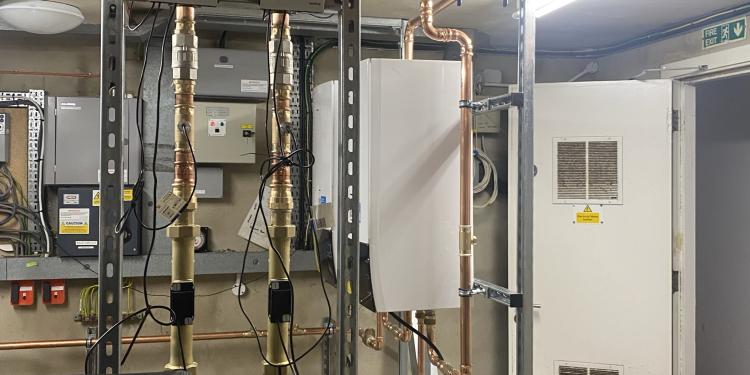Cambridge college creates innovative solutions to tackle climate change

Innovators at a Cambridge college have used government funding to help trigger a series of net zero measures – including using its riverside location as inspiration.
Darwin College is named after the Darwin family, Charles Darwin's second son, George Darwin, having owned some of the property which the college now occupies.
The college successfully applied for Public Sector Decarbonisation Scheme funding to remove old gas boilers and replace them with new air source heat pumps and related pipework. They have also installed three heat pumps for space heating, and two for water heating.
The works have been installed as part of the renovations at student accommodation, Frank Young House which was built in the 1990s.
A team from Salix visited the site on the River Cam, which accommodates students from more than 80 different countries studying a range of postgraduate degrees, to find out more.
Salix client support officer Kate Bowden said: “It is fascinating to see how the college has come up with innovative solutions.
“It has proved forward thinking and very creative in coming up with solutions to reducing carbon footprint.”
During the factfinding visit, the Salix team met Second Bursar Giles Greenfield and other members involved in the decarbonisation project.
Giles emphasised how important the Salix seed funding is to get these critical projects approved and progressed.
He also said how engaged the students had been in the works.
He added: “Darwin College offers an incredible research community, and our students are very much engaged.
“As a College, we are working towards putting environmental issues at the heart of our strategic and operational decisions and we believe Darwin is already recognised as being one of the greenest Cambridge Colleges.
“We are delighted to be exploring different technological solutions to heating our properties and making them more energy-efficient and we are delighted to work with Salix on this journey of decarbonisation.”
Other equipment installed at Frank Young House includes new radiators as well as a sound barrier which will be placed in front of the air source heat pumps and there are plans to have a flower bed planted along it.
New windows are also being installed in the back of the building and although these are not Salix funded, they are part of the ‘whole building’ approach.
Kate explained: “The college is using a new kind of window technology which provides triple glaze insultation levels, at a single glaze thickness, which although cost more, they are able to keep the current frames.
“This means they can protect the look of the buildings and maintain their value.”
Future vision
Since the River Cam runs along the back of the college, Giles and his team hope this can be used for river source heat and become the centre of a heat network which can service the main college building and some accommodation.
And Giles is liaising with other colleges downstream to see how they could be involved. Planning includes ecological considerations, as the heat extraction would lower the temperature of the river.
He believes this is a solid solution to climate change and says that as the earth warms, a cooler river will enable local wildlife to flourish.



